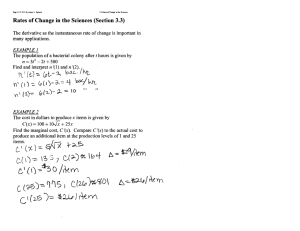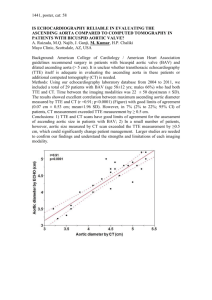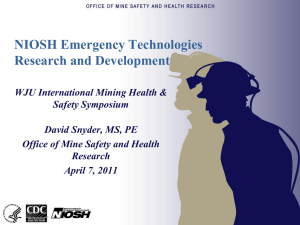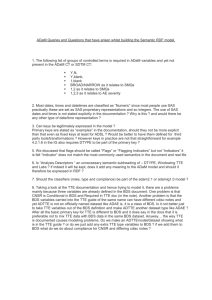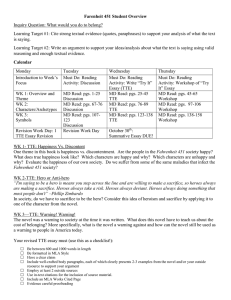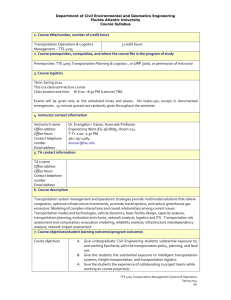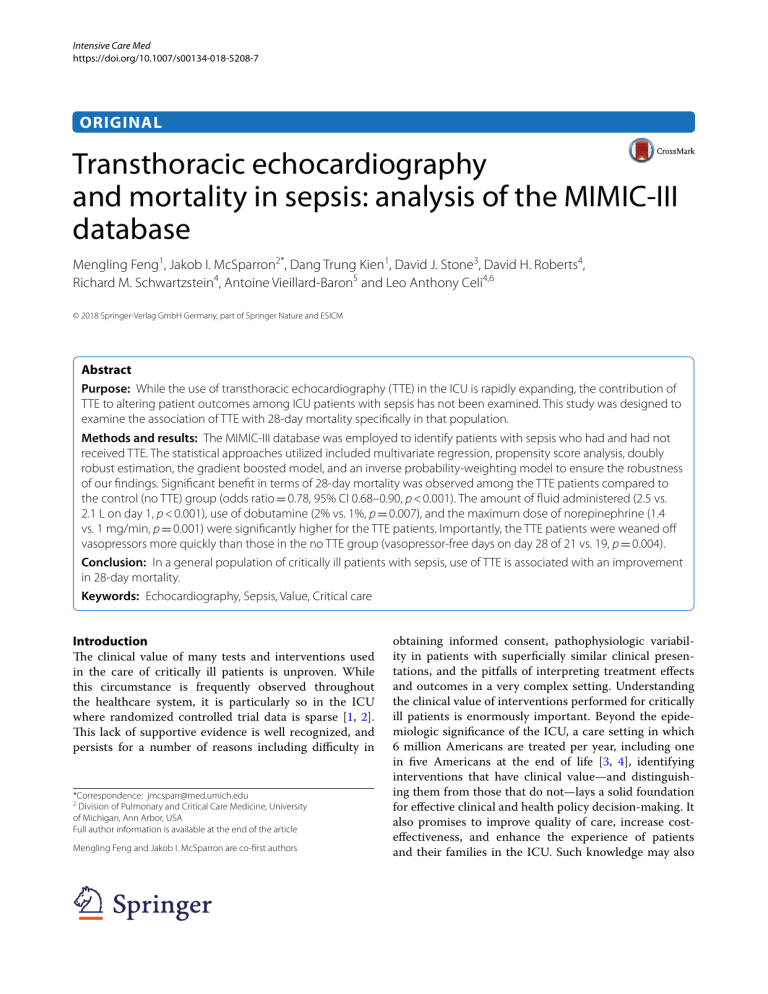
Intensive Care Med https://doi.org/10.1007/s00134-018-5208-7 ORIGINAL Transthoracic echocardiography and mortality in sepsis: analysis of the MIMIC‑III database Mengling Feng1, Jakob I. McSparron2*, Dang Trung Kien1, David J. Stone3, David H. Roberts4, Richard M. Schwartzstein4, Antoine Vieillard‑Baron5 and Leo Anthony Celi4,6 © 2018 Springer-Verlag GmbH Germany, part of Springer Nature and ESICM Abstract Purpose: While the use of transthoracic echocardiography (TTE) in the ICU is rapidly expanding, the contribution of TTE to altering patient outcomes among ICU patients with sepsis has not been examined. This study was designed to examine the association of TTE with 28-day mortality specifically in that population. Methods and results: The MIMIC-III database was employed to identify patients with sepsis who had and had not received TTE. The statistical approaches utilized included multivariate regression, propensity score analysis, doubly robust estimation, the gradient boosted model, and an inverse probability-weighting model to ensure the robustness of our findings. Significant benefit in terms of 28-day mortality was observed among the TTE patients compared to the control (no TTE) group (odds ratio = 0.78, 95% CI 0.68–0.90, p < 0.001). The amount of fluid administered (2.5 vs. 2.1 L on day 1, p < 0.001), use of dobutamine (2% vs. 1%, p = 0.007), and the maximum dose of norepinephrine (1.4 vs. 1 mg/min, p = 0.001) were significantly higher for the TTE patients. Importantly, the TTE patients were weaned off vasopressors more quickly than those in the no TTE group (vasopressor-free days on day 28 of 21 vs. 19, p = 0.004). Conclusion: In a general population of critically ill patients with sepsis, use of TTE is associated with an improvement in 28-day mortality. Keywords: Echocardiography, Sepsis, Value, Critical care Introduction The clinical value of many tests and interventions used in the care of critically ill patients is unproven. While this circumstance is frequently observed throughout the healthcare system, it is particularly so in the ICU where randomized controlled trial data is sparse [1, 2]. This lack of supportive evidence is well recognized, and persists for a number of reasons including difficulty in *Correspondence: jmcsparr@med.umich.edu 2 Division of Pulmonary and Critical Care Medicine, University of Michigan, Ann Arbor, USA Full author information is available at the end of the article Mengling Feng and Jakob I. McSparron are co-first authors obtaining informed consent, pathophysiologic variability in patients with superficially similar clinical presentations, and the pitfalls of interpreting treatment effects and outcomes in a very complex setting. Understanding the clinical value of interventions performed for critically ill patients is enormously important. Beyond the epidemiologic significance of the ICU, a care setting in which 6 million Americans are treated per year, including one in five Americans at the end of life [3, 4], identifying interventions that have clinical value—and distinguishing them from those that do not—lays a solid foundation for effective clinical and health policy decision-making. It also promises to improve quality of care, increase costeffectiveness, and enhance the experience of patients and their families in the ICU. Such knowledge may also reduce clinician burnout by reassuring providers that their interventions have clear-cut benefits [5]. Unsuspected cardiac abnormalities are frequently detected by echocardiography in critically ill patients [6]. While there is evidence that bedside transthoracic echocardiography (TTE) leads to management changes in up to 54% of critically ill patients, the importance and impact of these changes on patient outcomes have not been examined [7–9]. Recent evidence not limited to the critical care setting demonstrates that less than one-third of TTEs lead to an active change in care, with inpatient TTE studies even less likely to result in a change in management [10]. Similarly, in a recent large retrospective cohort study, preoperative echocardiography was not associated with improved mortality or shorter length of stay following non-cardiac surgery [11]. In contrast, a recent study using the National Inpatient Sample suggested that for specific diagnostic purposes, performance of TTE is associated with lower odds of inpatient mortality [12]. Studies thus far have primarily focused on management changes due to TTEs, but the outcome impact of these changes is not clear. While the widespread availability and noninvasive nature of TTE make it an appealing diagnostic tool, the marked increase in the use of TTE in the past 10 years has significant financial implications. Use of TTE increased by 90% from 1999 to 2008, accounting for over US$1.1 billion of medicare spending in 2010 [10, 13]. Given the increasing attention being placed on value-added care and excessive costs in the ICU, the impact of this expanding technology on patient care warrants further investigation. Although professional societies have published guidelines for appropriate use of TTE based on expert consensus, many clinicians are not familiar with these guidelines [14]. Notably, approximately 15% of studies are inappropriate according to these guidelines [15]. It has been argued that TTE use in the surgical intensive care unit (SICU) is not cost-effective because of a high failure rate, and addition of TTE variables to the APACHE II score does not improve prediction of mortality [16, 17]. In response to these many issues and questions, the current study was carried out to investigate the impact of TTE performance on the outcomes of critically ill adult patients with sepsis. Methods Study cohort This study is reported in accordance with the STrengthening the Reporting of OBservational studies in Epidemiology (STROBE) statement [18]. We conducted a longitudinal, single-center, retrospective study of adult patients from the medical intensive care units (MICU) and SICU with a diagnosis of sepsis based on the method established by Angus et al. [19] to retrospectively identify patients using billing codes. The study was designed to investigate whether formal TTE, performed by an echocardiography technologist and interpreted by a cardiologist, independently contributes to improvements in mortality and clinically important changes in the management of septic patients in the ICU. The project was approved by the institutional review boards of the Massachusetts Institute of Technology (MIT) and Beth Israel Deaconess Medical Center (BIDMC) and was granted a waiver of informed consent. We utilized the Medical Information Mart for Intensive Care (MIMIC) database, which was developed and is maintained by the Laboratory for Computational Physiology at MIT [20]. MIMIC-III contains data from 38,605 ICU patients and includes physiologic information from bedside monitors in the adult ICUs of BIDMC, a tertiary care university hospital, located in Boston, Massachusetts, USA. The database includes information from 2002 to 2011. Hourly physiologic readings from bedside monitors, validated by ICU nurses, were recorded. The database also contains records of demographics, laboratory results, nursing progress notes, intravenous (IV) medications, fluid balance, and other clinical variables. Specialists evaluated radiologic films at the time of patient care, and written evaluations were stored in the database along with the corresponding time stamps. International Classification of Diseases, Ninth Revision (ICD-9) codes were also documented for specific diseases by hospital staff on patient discharge. The database has extensive documentation of how data elements are captured as well as their fidelity. The documentation is provided not only by clinicians, data scientists, and information technology personnel at both BIDMC and MIT but also contributed to by the community of users who connect with those who generate the data in the context of research projects. Discussions around reliability of specific data elements are captured in a community white board to guide future investigators who may be interested in exploring similar concepts [21]. During the study period, the decision to perform a TTE was based on the clinical judgment of the medical team. There was no protocol in place or guidelines employed regarding performance of TTE in patients with sepsis. Only the data of each patient’s first ICU admission were used in this study. The patients who had TTE performed less than 24 h before their ICU admission or during their ICU stay were categorized as the TTE group, with the remaining patients making up the no TTE group. Primary outcome and secondary outcomes The primary outcome of the study was 28-day mortality from the date of ICU admission. Patient mortality information for discharged patients was gathered from the US Social Security Death Index. Secondary outcomes included number of mechanical ventilation- and vasopressor-free days within 28 days after ICU admission; use of dobutamine; maximum dose of norepinephrine; total IV fluid given to patients during their first, second, and third day in the ICU; and reductions in serum lactate and serum creatinine. The reductions in serum lactate and creatinine were calculated as follows: for the TTE patients, the difference between the last measurement before TTE and the first measurement 48 h after the TTE was calculated; for the no TTE patients, the difference between the first measurement after ICU admission and the first measurement 48 h after the initial measurement was calculated. Statistical methods The doubly robust estimation method was applied to infer the independent associations between TTE and patients’ primary and secondary outcomes. “Doubly robust estimation combines a multivariate regression model with a propensity score model to estimate the association and causal effect of an exposure on an outcome” [22, 23]. Conventionally, when one applies the regression model or the propensity score model individually to estimate a causal effect, both outcome regression and propensity score methods are unbiased only if both of the statistical models are correctly specified. The doubly robust estimator combines the two approaches such that only one of the two models needs to be correctly specified to obtain an unbiased effect estimator. The gradient boosted model (GBM) was employed for the estimation of patients’ propensity scores for TTE, so that covariate imbalance between the TTE and no TTE groups was minimized. GBM is a machine learning algorithm that consecutively constructs new models and forms an ensemble of models to provide a more accurate estimate of the response variable. The principal idea is to construct the new base-learners to be maximally correlated with the negative gradient of the predefined loss function. In our study, regression tree was used as the base learner of the GBM, and a total of 39 covariates were used in the model. Using the estimated propensity scores as weights, an inverse probabilities weighting (IPW) model was used to generate a weighted cohort [24]. A logistic regression was then performed on the weighted cohort, adjusting for the variables that remained unbalanced between the groups with and without a TTE in the propensity score model, thus the term doubly robust analysis. To evaluate the effectiveness of the propensity score model in balancing the two compared groups, the imbalance of covariates for the original and the adjusted (weighted) cohorts was compared. The standardized mean differences (SSMDs) between the TTE and no TTE groups were calculated. The Wilcoxon signed rank test, a non-parametric test, was used to statistically test the differences among the continuous covariates. A chi-square test was used to test the differences among the categorical covariates. For the comparison of the secondary outcomes, the TTE and no TTE patients were matched on the basis of estimated propensity scores. The SSMD and statistical significance of the observed differences were then calculated with the paired t test for continuous outcomes and McNemar’s test for categorical outcomes. Sensitivity analysis We conducted a series of sensitivity analyses to evaluate the robustness of the findings of the study and how our conclusions can be affected by applying various association inference models. In the sensitivity analysis, we applied four more association inference models: a doubly robust model adjusting for all covariates, a propensity score-based IPW model, a propensity score-based patient-matching model, and a logistic regression-based multivariate analysis model. The calculated effect sizes and p values from all these models were reported and compared. We also conducted a sensitivity analysis focusing only on those patients who had TTE performed within the first 48 h of their ICU stays. Covariates Demographic and admission information: age, gender, weight, day of the week of admission, time of admission, and severity at admission measured by SAPS score, SOFA score, and the Elixhauser comorbidity score [25–27]. Comorbidities Congestive heart failure (CHF), atrial fibrillation (AFIB), chronic renal disease, liver disease, chronic obstructive pulmonary disease (COPD), coronary artery disease (CAD), stroke, and malignant tumor. All of the comorbidities were identified on the basis of the recorded ICD-9 codes. (A detailed table of ICD-9 codes used for each comorbidity is included in the electronic supplementary material.) Vital signs Mean arterial pressure (MAP), heart rate, temperature (°F), and central venous pressure (CVP) readings at ICU admission. Interventions Use of mechanical ventilation, inotropic and vasopressor agents, and sedative drugs during the first 24 h of ICU admission. Laboratory results White blood cell (WBC) count, hemoglobin, platelet count, sodium, potassium, bicarbonate, chloride, blood urea nitrogen (BUN), lactate, creatinine, pH, partial pressure of oxygen (­PO2), partial pressure of carbon dioxide ­(PCO2), B-type natriuretic peptide (BNP), troponin, and creatinine kinase. We observed that CVP values were not collected for more than half of the patients in our cohort. If we directly used the CVP readings as the covariate, we would have had a large number of missing values. Instead, we utilized the presence or absence of CVP values as the covariate. Thus, a flag indicating whether CVP was recorded was included as a covariate in our models. Similarly, laboratory tests for BNP, troponin, and creatinine kinase were not ordered in more than half of the cohort. Therefore, flags indicating whether these tests were obtained were used as covariates (details about missing values can be found in the electronic supplementary material). The source codes for all analyses can be found at https ://github.com/nus-mornin-lab/echo-mimiciii. Results After reviewing 38,605 MIMIC-III adult admissions, we identified sepsis in 17,420 admissions according to the Angus methodology [19]. After including only patients’ first ICU admissions and excluding admissions to the coronary care unit (CCU) and the cardiac surgical unit, we included 6361 patients in our study cohort (Fig. 1). TTE was ordered for 51.3% of patients during or in the period less than 24 h before their ICU admission. The characteristics of the cohort are summarized in Table 1. The TTE patients had significantly higher severity scores on admission: SAPS-I score 20.75 (± 5.44) vs. 19.63 (± 5.78), and SOFA score 6.3 (± 3.8) vs. 5.3 (± 3.62). A larger percentage of the TTE patients received mechanical ventilation (58% vs. 47%) and vasopressor treatment (38% vs. 27%) during the first 24 h of their ICU stay. Doubly robust analysis A propensity score model was first constructed employing the 39 covariates with the GBM. The contributions of individual covariates to the final propensity score are illustrated in Fig. 2. The top covariates include age, history of atrial fibrillation, presence of CHF, heart rate, and SOFA score: unsurprisingly, these covariates represent common factors influencing physicians’ decisions regarding whether to perform TTE. Based on the estimated propensity scores, IPW was applied to standardize the differences between the TTE and no TTE cohorts [24]. As shown in Table 1, most of the covariates of the weighted cohorts were similar or “balanced” between the groups with and without echocardiograms. The exceptions were SOFA score; mechanical ventilation; use of inotropic, vasopressor and/or sedative medications; the availability of BNP, troponin, and creatinine kinase values; and two comorbid conditions (CHF and atrial fibrillation). Under the doubly robust estimation framework, a regression model was developed to adjust for these unbalanced covariates on the weighted cohort. Primary outcome and sensitivity studies Fig. 1 Study cohort. Illustration of exclusion and inclusion criteria as utilized to select the final cohort of 6361 patients The doubly robust analysis demonstrated a significant beneficial effect of TTE in terms of the 28-day mortality. The propensity score-matched mortality rates for the TTE and no TTE groups were 25% vs. 30%. The adjusted odds ratio was 0.78 (95% CI 0.68–0.90, p < 0.001). For the sensitivity analysis, as summarized in Table 2, all five Table 1 Comparison of the basic demographics, comorbidity conditions, and day of ICU admissions between the original cohort and the adjusted (weighted) cohort Covariate Original cohort No TTE Matched cohort TTE n 3099 3262 Age 66.69 (17.21) 65.74 (16.55) Missing data (%) SSMD No TTE TTE 1626 1626 0.056 66.58 (16.54) 65.84 (17.07) SSMD NA 0.044 0.0 Gender (female) 50.80% 47.80% 0.061 48.00% 49.00% 0.021 0.0 Service unit (MICU %) 77.60% 79.50% 0.047 78.40% 78.90% 0.014 0.0 Weight (kg) 78.56 (23.58) 83.17 (26.87) 0.182 81.35 (24.69) 79.50 (23.11) 0.077 9.4 SAPS score 19.63 (5.79) 20.76 (5.44) 0.202 20.29 (5.42) 19.80 (5.17) 0.092 0.0 SOFA score 5.31 (3.62) 6.33 (3.79) 0.277 5.99 (3.74) 5.55 (3.50) 0.123 0.0 Elixhauser score 8.5 (7.45) 10.07 (7.67) 0.207 9.54 (7.67) 8.82 (7.52) 0.096 0.0 Interventions Mechanical ventilation use (1st 24 h) 47.10% 58.30% 0.226 52.30% 49.60% 0.055 0.0 Vasopressor use (1st 24 h) 27.10% 37.60% 0.227 32.70% 31.20% 0.032 0.0 Sedative use (1st 24 h) 40.20% 49.80% 0.192 43.80% 42.80% 0.021 0.0 Comorbidities CHF 18.20% 40.00% 0.495 28.80% 19.40% 0.221 0.0 AFIB 20.10% 32.40% 0.282 27.60% 24.80% 0.062 0.0 Renal 14.10% 16.40% 0.066 15.40% 14.30% 0.031 0.0 Liver 10.10% 11.20% 0.034 11.40% 11.90% 0.013 0.0 COPD 15.20% 17.50% 0.063 17.80% 15.60% 0.061 0.0 CAD 11.90% 15.80% 0.113 13.20% 13.20% 0.002 0.0 Stroke 7.70% 10.80% 0.106 8.80% 8.70% 0.002 0.0 Malignancy 25.20% 22.30% 0.068 25.00% 25.20% 0.003 0.0 Vital signs MAP 79.91 (19.44) 80.03 (20.48) 0.006 80.13 (19.95) 80.13 (20.05) 0.009 1.2 Heart rate 93.01 (19.81) 95.07 (21.79) 0.099 94.88 (20.77) 93.88 (20.04) 0.049 1.2 Temperature (°C) 36.75 (1.05) 36.85 (1.90) 0.07 36.8 (1.06) 36.86 (1.85) 0.031 1.6 CVP 11.88 (17.09) 13.74 (20.45) 0.099 12.4 (19.95) 11.86 (11.63) 0.033 64.5 Laboratory tests WBC 13.48 (14.03) 13.76 (12.41) 0.021 13.7 (15.17) 13.70 (13.84) 0.001 4.1 Hemoglobin 10.55 (1.98) 10.60 (2.04) 0.021 10.56 (2.01) 10.57 (2.02) 0.009 4.0 Platelet 223.96 (134.79) 211.55 (128.46) 0.094 215.31 (130.72) 216.43 (129.90) 0.009 4.1 Sodium 139.09 (6.45) 138.56 (5.89) 0.086 138.75 (5.88) 138.52 (6.08) 0.039 2.6 Potassium 4.10 (0.79) 4.15 (0.84) 0.061 4.12 (0.79) 4.09 (0.76) 0.033 2.4 Bicarbonate 22.28 (5.40) 22.35 (5.71) 0.012 22.39 (5.67) 22.30 (5.33) 0.018 2.9 Chloride 106.2 (7.45) 105.14 (7.20) 0.145 105.50 (7.14) 105.47 (7.21) 0.004 2.6 BUN 32.02 (26.34) 36.01 (27.38) 0.149 34.05 (26.40) 32.4 (25.57) 0.063 2.8 Lactate 2.62 (2.35) 2.5 (2.27) 0.047 2.58 (2.21) 2.47 (2.14) 0.049 38.2 Creatinine 1.60 (1.66) 1.83 (1.81) 0.132 1.72 (1.68) 1.63 (1.64) 0.053 2.8 pH 7.35 (0.11) 7.34 (0.11) 0.043 7.34 (0.11) 7.35 (0.11) 0.086 30.5 PO 2 147.61 (107.49) 133.24 (93.89) 0.142 135.33 (98.90) 139.78 (100.24) 0.045 33.1 PCO2 41.48 (13.34) 42.77 (14.83) 0.091 42.18 (13.69) 41.46 (13.81) 0.053 33.1 BNP (tested) 1.20% 4.40% 0.196 2.20% 1.50% 0.05 0.0 Troponin (tested) 20.40% 40.70% 0.451 31.90% 24.10% 0.173 0.0 Creatinine kinase (tested) 37.20% 59.30% 0.452 51.80% 44.00% 0.157 0.0 12.70% 14.20% 14.40% 12.90% 0.148 Day of lCU admission Sunday 0.093 Monday 13.40% 14.60% 13.00% 13.70% Tuesday 13.80% 15.10% 13.70% 15.70% Table 1 continued Covariate Original cohort No TTE Matched cohort TTE SSMD No TTE Missing data (%) TTE Wednesday 13.60% 15.80% 15.40% 13.80% Thursday 15.00% 15.30% 14.60% 14.50% Friday 17.40% 13.70% 15.70% 17.10% Saturday 14.10% 11.40% 13.20% 12.20% SSMD 0.0 For all continuous covariates, the mean values and standard deviations are reported. For both cohorts, covariate entries in bold have p values < 0.05 Fig. 2 Relative influence factor of covariates. The relative influence factor measures how discriminative the 39 covariates of the propensity score model are when predicting the likelihood of echocardiogram performance estimation models led to the same conclusion: patients who had TTE had lower 28-day mortalities. We also conducted a sensitivity study to include only patients with TTE performed within the first 48 h and observed the same findings (electronic supplementary material). Secondary outcomes studies with propensity score matching We evaluated a number of secondary outcomes to investigate potential factors that might account for the beneficial effects of TTE. Several key differences in secondary outcomes were observed. First, the amount of fluid administered to the TTE group was significantly Table 2 Primary outcome analysis with five different models: (1) doubly robust model with unbalanced covariates (2) doubly robust model with all covariates, (3) propensity score IPW model, (4) propensity score matching model, (5) multivariate logistic regression model Method OR CI p value 2.5% 97.5% Doubly robust with unbalanced covari‑ ates 0.78 0.68 0.90 < 0.001 Doubly robust with all covariates 0.64 0.52 0.78 < 0.001 Propensity score IPW 0.84 0.78 0.92 < 0.001 Propensity score matching 0.78 0.66 0.92 < 0.001 Multivariate 0.64 0.53 0.78 < 0.001 higher on day 1 (2.5 vs. 2.1 L, p < 0.001), day 2 (1.3 vs. 0.9 L, p < 0.001), and day 3 (0.8 vs. 0.3 L, p < 0.001). Second, the use of dobutamine (2% vs. 1%, p < 0.001) and, when administered, the maximum dose of norepinephrine (1.4 vs. 1 mg/min, p < 0.001) were significantly higher for the TTE patients. Third, the TTE group had a significantly shorter duration of vasopressor use (vasopressorfree days on day 28 of 21 vs. 19, p < 0.001). The duration of mechanical ventilation did not significantly differ between the two groups. Differences in the reduction of lactate and creatinine values were not significant. These comparisons are for those values recorded nearest the time stamp of the TTE with those from 48 h later for the TTE group, and the values recorded on days 1 and 3 for the non TTE group. The detailed results are summarized in Table 3. Discussion Identifying clinical value is challenging when innovations in healthcare are studied [28, 29]. This challenge only increases in complex, dynamic environments like the ICU. At times, new technologies diffuse rapidly on the basis of theoretical benefits from our understanding of disease pathophysiology, but before rigorous evaluations of benefits and harm are performed. Similarly, innovations which have been found to be beneficial in specific patient populations may be applied to other populations in which they have not been adequately studied, potentially exposing patients to harm (and added expense) without commensurate benefit [5]. Notable examples of this phenomenon include the initial enthusiasm for and subsequent decline in pulmonary artery catheter utilization, routine use of invasive cardiac catheterization in the initial evaluation of patients with stable coronary disease, and utilization of cardiac computed tomography angiography [30–38]. Examples of other technologies that are commonly used in the ICU but have received little formal utility assessment include electrolyte repletion to restore normal range values, insertion of central venous catheters, and the use of indwelling arterial catheters [39]. The advent of electronic medical records provides a powerful tool for investigating the clinical effectiveness of technologies using real-world data [40]. In light of the uncertainty surrounding the value of most diagnostic tests and interventions used in the ICU, as well as the implications that this evidence gap has for practice and policy, we describe a novel framework that exemplifies how big data can be employed for measuring impact on clinical and/or patient-centered outcomes. While the use of TTE has steadily increased over the past decade, the implications for patient outcomes remain unknown [12]. There is limited data available in the literature regarding the utility of TTE in critically ill, septic patients: A recent study by Papolos et al. [12] found that use of TTE was associated with lower odds of in-hospital mortality among patients hospitalized for five specific diagnoses, including sepsis. In our study, patients who had TTE had higher severity of illness scores, more comorbid conditions, and were more likely to receive mechanical ventilation, inotropic, vasopressor, and sedative agents. Despite these factors pointing to a sicker group of patients, we found a significantly lower 28-day mortality among patients who had TTE after adjustment for confounding. Considering the factors displayed in Fig. 2, clinicians may particularly want to consider TTE early in the ICU stay for patients with sepsis. We tested several hypotheses to account for the mortality benefit, and compared several variables between Table 3 Secondary outcome analysis with propensity score matched cohorts Secondary outcomes Non TTE TTE Effect size p value Missing data% Ventilation-free days in 28 days 18 (14.70) 20 (32.64) 0.06 0.1 0 Vasopressor-free days in 28 days 19 (12.73) 21 (16.95) 0.1 < 0.001 0 Dobutamine use 1% 2.1% 1.1% < 0.001 0 Norepinephrine (maximum dosage mg/min) 1.04 (2.68) 1.38 (3.13) 0.117 < 0.001 0 IV fluid day 1 (mL) 2112.35 (3372.21) 2492.39 (3768.86) 0.089 < 0.001 10 IV fluid day 2 (mL)a 900.41 (2557.54) 1275.30 (2872.91) 0.138 < 0.001 18 IV fluid day 3 (mL)a 253.25 (2147.55) 771.78 (2683.65) 0.213 < 0.001 34 Serum lactate ­reductionb 0.23 (1.94) 0.53 (2.4) 0.06 0.5 68.9 Serum creatinine ­reductionb 0.08 (0.65) 0.12 (0.58) 0.003 0.3 9.3 For the use of dobutamine, the difference in the percentage of patients was calculated as the effect size. For the other secondary outcomes, mean values and standard deviations were reported, and the standardized mean differences (SSMD) were calculated as the effect size a Patients who were dead or discharged from the hospital before day 2 or 3 were excluded b Patients who were dead or discharged from the hospital within 48 h of TTE (TTE group) or initial laboratory value (no TTE group) were excluded the patients with and without TTE. More fluids were administered to the TTE group on days 1, 2, and 3 in the ICU. Dobutamine was used more often in the group who received TTE, but this might be because a history of CHF was more frequent among this group, i.e., it is not certain whether the TTE triggered the use of dobutamine or if it had already been in place. Those who had TTE also had a higher maximum dose of norepinephrine, but surprisingly were weaned off vasopressors earlier compared to the no TTE group. Whether the mortality improvements are entirely due to the differences in the volume of fluid administered, dobutamine use, and/or maximum dose of norepinephrine is impossible to assess given the sample size. Our findings raise the possibility that TTE provides information to physicians that may aid in the management of critically ill septic patients. We fully realize that observational, database studies of this kind require careful, multifaceted, and rigorous statistical approaches in order to produce valid, reliable, and actionable results. We believe that we have done so in this regard for the subject at hand, and intend to pursue further such analyses in the future in order to minimize the ambiguity of clinical decision-making in the confounding and complex environment posed by the ICU. The findings should in no way be taken as the final and definitive word with regard to the value of TTE in the management of sepsis in the ICU. As an observational single-center study retrospectively performed on electronic health record data, the potential issues of residual confounding by variables not captured in the electronic health record (EHR), as well as generalizability of the findings to other institutions, require additional investigation. The outcomes were not adjusted for year of ICU admission, which is a limitation of the analysis as practice patterns may have changed during the study period. Additionally, the lack of a standardized protocol related to performance of a TTE in septic patients during this study period may limit the generalizability of these results. This paper was undertaken to exemplify the way secondary analysis of EHR data can be utilized to evaluate tests and treatments that have been widely adopted into practice on the basis of theoretical or limited (with respect to patient cohort and/or surrogate outcome) benefits. Some analyses will require prospective randomized trials for confirmation as was the case of pulmonary artery catheter use in the ICU, but in some cases retrospective studies are adequate, as in the case of rofecoxib withdrawal from the market or to convince the public of the cancer risk of smoking. Conclusions The performance of TTE is associated with a 28-day mortality benefit in a general population of septic, critically ill patients. The mechanism of this benefit remains to be explored but may be related to the increased use of fluids and vasoactive agents as indicated and guided by TTE results. Given that for most of ICU practice, randomized controlled trial (RCT)-based data are lacking and no RCT will likely be performed to provide evidence in the future, the application of the real-world data that is captured in EHRs is necessary to assess the clinical effectiveness of interventions such as TTE. While these investigations must be performed with full awareness of and attention to the complexity, and possible confounding by indication, of such data applications, they are now quite feasible and, we feel, absolutely necessary in the future development and evolution of optimal clinical care. Electronic supplementary material The online version of this article (https://doi.org/10.1007/s00134-018-5208-7) contains supplementary material, which is available to authorized users. Author details 1 Saw Swee Hock School of Public Health, National University Health System, National University of Singapore, Singapore, Singapore. 2 Division of Pul‑ monary and Critical Care Medicine, University of Michigan, Ann Arbor, USA. 3 Departments of Anesthesiology and Neurosurgery, University of Virginia School of Medicine, Charlottesville, USA. 4 Division of Pulmonary, Critical Care and Sleep Medicine, Beth Israel Deaconess Medical Center, Boston, USA. 5 Hos‑ pital Ambroise Paré, Assistance Publique-Hôpitaux de Paris, Boulogne, France. 6 Institute for Medical Engineering and Science, Massachusetts Institute of Technology, Cambridge, USA. Compliance with ethical standards Conflicts of interest The authors declare that they have no competing interests. Received: 30 December 2017 Accepted: 5 May 2018 References 1. Angus DC (2007) Caring for the critically ill patient: challenges and oppor‑ tunities. JAMA 298:456–458. https://doi.org/10.1001/jama.298.4.456 2. Singer M, Matthay MA (2011) Clinical review: thinking outside the box— an iconoclastic view of current practice. Crit Care 15:225. https://doi. org/10.1186/cc10245 3. Angus DC, Barnato AE, Linde-Zwirble WT et al (2004) Use of intensive care at the end of life in the United States: an epidemiologic study. Crit Care Med 32:638–643 4. Society of Critical Care Medicine (2018) Critical care statistics. http://www. sccm.org/Communications/Pages/CriticalCareStats.aspx. Accessed 8 Feb 2018 5. Moss M, Good VS, Gozal D et al (2016) An official Critical Care Societies Collaborative statement—burnout syndrome in critical care healthcare professionals. Chest 150:17–26. https://doi.org/10.1016/j.chest .2016.02.649 6. Bossone E, DiGiovine B, Watts S et al (2002) Range and prevalence of cardiac abnormalities in patients hospitalized in a medical ICU. Chest 122:1370–1376 7. 8. 9. 10. 11. 12. 13. 14. 15. 16. 17. 18. 19. 20. 21. Stanko LK, Jacobsohn E, Tam JW et al (2005) Transthoracic echocardiogra‑ phy: impact on diagnosis and management in tertiary care intensive care units. Anaesth Intensive Care 33:492–496 Tam JW, Nichol J, MacDiarmid AL et al (1999) What is the real clinical utility of echocardiography? A prospective observational study. J Am Soc Echocardiogr 12:689–697 Orme RML, Oram MP, McKinstry CE (2009) Impact of echocardiogra‑ phy on patient management in the intensive care unit: an audit of district general hospital practice. Br J Anaesth 102:340–344. https://doi. org/10.1093/bja/aen378 Matulevicius SA, Rohatgi A, Das SR et al (2013) Appropriate use and clinical impact of transthoracic echocardiography. JAMA Intern Med 173:1600–1607. https://doi.org/10.1001/jamainternmed.2013.8972 Wijeysundera DN, Beattie WS, Karkouti K et al (2011) Association of echo‑ cardiography before major elective non-cardiac surgery with postopera‑ tive survival and length of hospital stay: population based cohort study. BMJ 342:d3695 Papolos A, Narula J, Bavishi C et al (2016) US hospital use of echocardiog‑ raphy: insights from the nationwide inpatient sample. J Am Coll Cardiol 67:502–511. https://doi.org/10.1016/j.jacc.2015.10.090 Andrus BW, Welch HG (2012) Medicare services provided by cardiologists in the United States: 1999–2008. Circ Cardiovasc Qual Outcomes 5:31–36. https://doi.org/10.1161/CIRCOUTCOMES.111.961813 Douglas PS, Garcia MJ, Haines DE et al (2011) ACCF/ASE/AHA/ASNC/ HFSA/HRS/SCAI/SCCM/SCCT/SCMR 2011 appropriate use criteria for echocardiography. A report of the American College of Cardiology Foundation Appropriate Use Criteria Task Force, American Society of Echocardiography, American Heart Association, American Society of Nuclear Cardiology, Heart Failure Society of America, Heart Rhythm Society, Society for Cardiovascular Angiography and Interventions, Society of Critical Care Medicine, Society of Cardiovascular Computed Tomography, Society for Cardiovascular Magnetic Resonance American College of Chest Physicians. J Am Soc Echocardiogr 24:229–267. https:// doi.org/10.1016/j.echo.2010.12.008 Ward RP, Krauss D, Mansour IN et al (2009) Comparison of the clinical application of the American College of Cardiology Foundation/American Society of Echocardiography appropriateness criteria for outpatient transthoracic echocardiography in academic and community practice settings. J Am Soc Echocardiogr 22:1375–1381. https://doi.org/10.1016/j. echo.2009.08.005 Cook CH, Praba AC, Beery PR, Martin LC (2002) Transthoracic echocar‑ diography is not cost-effective in critically ill surgical patients. J Trauma 52:280–284 Sawchuk CWT, Wong DT, Kavanagh BP, Siu SC (2003) Transthoracic echo‑ cardiography does not improve prediction of outcome over APACHE II in medical-surgical intensive care. Can J Anaesth 50:305–310. https://doi. org/10.1007/BF03017803 STROBE Group (2016) STROBE statement: home. http://www.strobe-state ment.org/index.php?id=strobe-home. Accessed 12 Dec 2016 Angus DC, Linde-Zwirble WT, Lidicker J et al (2001) Epidemiology of severe sepsis in the United States: analysis of incidence, outcome, and associated costs of care. Crit Care Med 29:1303–1310 Johnson AEW, Pollard TJ, Shen L et al (2016) MIMIC-III, a freely accessible critical care database. Sci Data 3:160035. https://doi.org/10.1038/sdata .2016.35 Johnson AE, Stone DJ, Celi LA, Pollard TJ (2018) The MIMIC code reposi‑ tory: enabling reproducibility in critical care research. J Am Med Inform Assoc 25:32–39. https://doi.org/10.1093/jamia/ocx084 22. McCaffrey DF, Griffin BA, Almirall D et al (2013) A tutorial on propensity score estimation for multiple treatments using generalized boosted models. Stat Med 32:3388–3414. https://doi.org/10.1002/sim.5753 23. Funk MJ, Westreich D, Wiesen C et al (2011) Doubly robust estimation of causal effects. Am J Epidemiol 173:761–767. https://doi.org/10.1093/aje/ kwq439 24. Cole SR, Hernan MA (2008) Constructing inverse probability weights for marginal structural models. Am J Epidemiol 168:656–664. https://doi. org/10.1093/aje/kwn164 25. Le Gall JR, Loirat P, Alperovitch A et al (1984) A simplified acute physiol‑ ogy score for ICU patients. Crit Care Med 12:975–977 26. Vincent JL, Moreno R, Takala J et al (1996) The SOFA (Sepsis-related Organ Failure Assessment) score to describe organ dysfunction/failure. On behalf of the working group on Sepsis-Related Problems of the European Society of Intensive Care Medicine. Intensive Care Med 22:707–710 27. van Walraven C, Austin PC, Jennings A et al (2009) A modification of the Elixhauser comorbidity measures into a point system for hospital death using administrative data. Med Care 47:626–633. https://doi.org/10.1097/ MLR.0b013e31819432e5 28. Coye MJ, Kell J (2006) How hospitals confront new technology. Health Aff (Millwood) 25:163–173 29. Fisher ES, Welch HG (1999) Avoiding the unintended consequences of growth in medical care: how might more be worse? JAMA 281:446–453 30. Wheeler AP, Bernard GR, Thompson BT et al (2006) Pulmonary-artery versus central venous catheter to guide treatment of acute lung injury. N Engl J Med 354:2213–2224. https://doi.org/10.1056/NEJMoa061895 31. Yu DT, Platt R, Lanken PN et al (2003) Relationship of pulmonary artery catheter use to mortality and resource utilization in patients with severe sepsis. Crit Care Med 31:2734–2741. https://doi.org/10.1097/01. CCM.0000098028.68323.64 32. Sandham JD, Hull RD, Brant RF et al (2003) A randomized, controlled trial of the use of pulmonary-artery catheters in high-risk surgical patients. N Engl J Med 348:5–14. https://doi.org/10.1056/NEJMoa021108 33. Connors AF, Speroff T, Dawson NV et al (1996) The effectiveness of right heart catheterization in the initial care of critically ill patients. Support investigators. JAMA 276:889–897 34. Matthay MA, Chatterjee K (1988) Bedside catheterization of the pulmo‑ nary artery: risks compared with benefits. Ann Intern Med 109:826–834 35. Boden WE, O’Rourke RA, Teo KK et al (2007) Optimal medical therapy with or without PCI for stable coronary disease. N Engl J Med 356:1503–1516. https://doi.org/10.1056/NEJMoa070829 36. Mitka M (2006) CT angiography: clearer picture, fuzzier reception. JAMA 295:1989–1990. https://doi.org/10.1001/jama.295.17.1989 37. Ladapo JA, Horwitz JR, Weinstein MC et al (2009) Adoption and spread of new imaging technology: a case study. Health Aff (Millwood) 28:w1122– w1132. https://doi.org/10.1377/hlthaff.28.6.w1122 38. Ladapo JA, Jaffer FA, Hoffmann U et al (2009) Clinical outcomes and costeffectiveness of coronary computed tomography angiography in the evaluation of patients with chest pain. J Am Coll Cardiol 54:2409–2422. https://doi.org/10.1016/j.jacc.2009.10.012 39. Hsu DJ, Feng M, Kothari R et al (2015) The association between indwell‑ ing arterial catheters and mortality in hemodynamically stable patients with respiratory failure: a propensity score analysis. Chest 148:1470–1476. https://doi.org/10.1378/chest.15-0516 40. Ghassemi M, Celi L, Stone DJ (2015) State of the art review: the data revolution in critical care. Crit Care 19:118. https://doi.org/10.1186/s1305 4-015-0801-4
